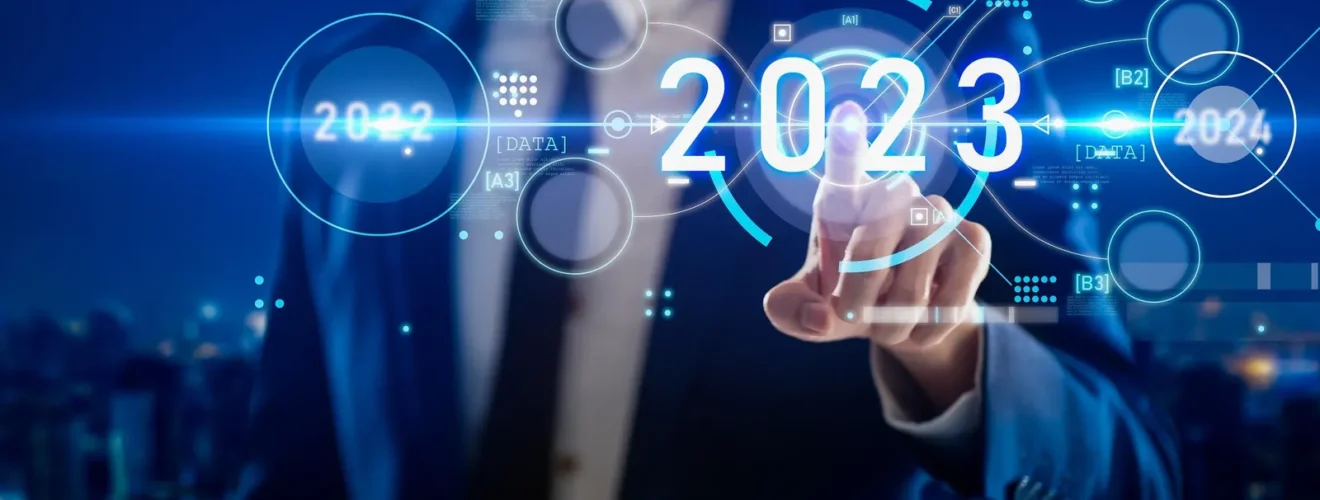Tech Forecast: 10 Trends on the Horizon for 2023

As someone with a focus on the future, I regularly explore upcoming tech developments that will influence our digital landscape in the coming year. Which technologies are making significant progress, and what trends should business leaders anticipate?
Explore the upcoming tech developments to watch in the year ahead.
1. AI’s Widespread Influence
In 2023, organizations will witness the tangible integration of artificial intelligence. The advent of no-code AI, featuring user-friendly drag-and-drop interfaces, will empower businesses to harness its capabilities for creating smarter products and services. A prominent example of this shift is evident in the retail sector, where companies like Stitch Fix utilize AI-driven algorithms to suggest personalized clothing options based on customer preferences and sizes.
The year 2023 will see a surge in contactless, autonomous shopping, and delivery, streamlining payment and product receipt processes for consumers. AI’s pervasive influence will extend to diverse industries, enhancing various job roles and business operations. Retailers, in particular, will increasingly adopt AI for managing and automating intricate inventory processes, paving the way for standard practices like buy-online-pickup-at-curbside (BOPAC), buy-online-pickup-in-store (BOPIS), and buy-online-return-in-store (BORIS). Additionally, AI will power the latest initiatives in autonomous delivery, requiring retail workers to adapt to collaborative work settings with machines.
2. Realization of Metaverse Components on the Horizon
I’m not a fan of the term ‘metaverse,’ but it’s commonly used to describe a more immersive internet where work, play, and social interactions occur on a continuous platform.
“Industry forecasts indicate a potential $5 trillion boost to the global economy from the metaverse by 2030, with 2023 poised to shape its trajectory for the next decade.
Advancements in augmented reality (AR) and virtual reality (VR) technologies are anticipated. The metaverse’s work environment is a focal point, with expectations of more immersive meeting spaces in the upcoming year, facilitating collaborative discussions and co-creation. Microsoft and Nvidia are already in the process of developing metaverse platforms for joint digital projects.
The evolution of avatar technology is another highlight for the year ahead. Avatars, representing our presence in the metaverse, may mirror our real-world appearance, incorporating motion capture for authentic body language and gestures. The emergence of AI-driven autonomous avatars acting as digital representatives, even when users are offline, is a potential development. Companies are increasingly leveraging metaverse tools like AR and VR for training and onboarding, a trend set to escalate in 2023. Accenture, for instance, has introduced the Nth Floor, a metaverse environment replicating physical offices. This virtual space enables new hires and existing employees to engage in HR tasks without a physical office presence.
3. Web3 Advancement
In 2023, there will be notable advancements in blockchain technology as companies increasingly develop decentralized products and services. Consider our current reliance on cloud storage for everything. By decentralizing data storage and employing blockchain-based encryption, not only will our information become more secure, but we will also unlock innovative methods for accessing and analyzing it.
The practicality and utility of non-fungible tokens (NFTs) are set to increase in the coming year. For instance, NFT tickets for concerts might offer exclusive access to backstage experiences and collectibles. NFTs could potentially serve as the means for interacting with various digital products and services we purchase, or even represent contracts entered into with other parties.
4. Building Connections Between the Digital and Physical Dimensions
The convergence of the digital and physical realms is already underway, and this trend is set to persist in 2023, driven by two key elements: digital twin technology and 3D printing.
Digital twins serve as virtual replicas of real-world processes, operations, or products, providing a secure digital environment for testing new concepts. Designers and engineers leverage digital twins to recreate physical objects within virtual settings, enabling thorough testing under various conditions without the expenses associated with real-world experiments. In the upcoming year, expect a surge in digital twins, spanning from factories and machinery to cars and precision healthcare.
Following virtual testing, engineers can refine components and then bring them into the physical realm using 3D printing technology. Illustratively, Formula 1 teams presently gather data from sensors during races, along with information on race track temperatures and weather conditions. This data is then streamed to digital twins of engines and car components, allowing teams to conduct scenario-based design changes in real-time. Subsequently, the teams utilize 3D printing to manufacture car parts based on the outcomes of their virtual testing.5.
5. Advancing Editable Features
A future awaits where we can modify materials, plants, and even humans through advanced editing capabilities. Nanotechnology will empower us to craft materials with entirely novel features, including water resistance and self-healing properties.
While CRISPR-Cas9 has been in use for a few years, 2023 will witness the acceleration of gene editing technology, providing us with an enhanced ability to “edit nature” by modifying DNA. The concept of gene editing is akin to word processing, allowing for the removal and addition of genetic elements, providing solutions to DNA mutations, addressing food allergies, enhancing crop health, and even adjusting human traits like eye and hair color.
6. Advancements in Quantum Technologies
Presently, a global competition is underway to achieve large-scale quantum computing. Quantum computing, utilizing subatomic particles to revolutionize information processing and storage, represents a significant technological advancement. It holds the promise of delivering computers with processing speeds a trillion times faster than today’s fastest traditional processors. However, the potential peril lies in the capability of quantum computing to render current encryption methods obsolete. Consequently, any nation achieving quantum computing at scale could potentially breach the encryption systems of other nations, businesses, security protocols, and more. This unfolding development is a crucial trend to monitor closely in 2023, as major nations like the US, UK, China, and Russia invest heavily in the advancement of quantum computing technology.
7. Innovations in Eco-Friendly Technology
One of the paramount challenges confronting the world today is curbing our carbon emissions to address the climate crisis. In 2023, anticipate ongoing advancements in green hydrogen, an emerging clean-burning energy source with minimal greenhouse gas emissions. Major European energy companies like Shell and RWE are spearheading the creation of the first substantial green pipeline, connecting wind plants in the North Sea.
Another notable development will be in the establishment of decentralized power grids. This model of distributed energy generation involves a network of small power generators and storage units located within communities or individual residences. This setup ensures the availability of power even in the absence of the main grid. While our current energy system is predominantly controlled by large gas and energy corporations, decentralized energy initiatives have the potential to democratize power globally while simultaneously reducing carbon emissions.
8. Advancing Human-Like Features in Robots
In 2023, robots will become even more like humans — in appearance and capability. These types of robots will be used in the real world as event greeters, bartenders, concierges, and companions for older adults. They’ll also perform complex tasks in warehouses and factories as they work alongside humans in manufacturing and logistics.
One company is working hard to create a human-like robot that will work in our homes. At Tesla AI Day in September 2022, Elon Musk revealed two Optimus humanoid robot prototypes, and said the company would be ready to take orders within the next 3 to 5 years. The robot can perform simple tasks like lifting items and watering plants — so perhaps soon we’ll be able to have “robot butlers” that help around in the house.
9. Evolution in Autonomous Systems
Business leaders will persist in advancing the development of autonomous systems, particularly in the realm of delivery and logistics.
Many factories and warehouses have already embraced partial or complete autonomy. In 2023, the prevalence of self-driving trucks, ships, and delivery robots is set to increase. Furthermore, more warehouses and factories will adopt autonomous technology for enhanced efficiency.
A case in point is Ocado, a leading British online supermarket touting itself as the “world’s largest dedicated online grocery retailer.” Ocado employs thousands of autonomous robots in its highly automated warehouses, handling tasks such as sorting, lifting, and moving groceries. The warehouse leverages AI to strategically position the most popular items within easy reach of the robots. Ocado is extending the use of its successful autonomous technology from its warehouses to other grocery retailers.
10. Evolution in Sustainable Technology
In 2023, there will be a heightened focus on promoting more sustainable technology. With many of us heavily reliant on devices such as smartphones, tablets, and computers, there is an increasing awareness of the sourcing of components used in manufacturing our favorite gadgets. People will be more mindful of the origins of rare earth components, particularly those used in computer chips, and the impact of their consumption.
Additionally, as we continue to utilize cloud services like Netflix and Spotify, it’s essential to recognize that these platforms operate in large data centers that consume significant amounts of energy. The upcoming year will witness a sustained effort to enhance transparency in supply chains, driven by consumer demand for products and services that prioritize energy efficiency and embrace more sustainable technology.








